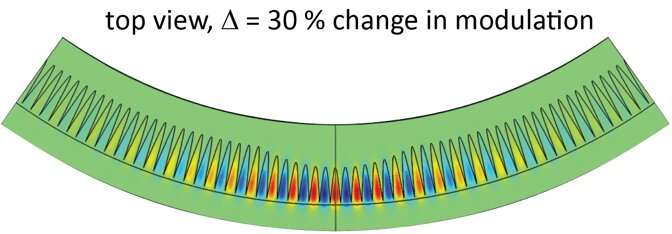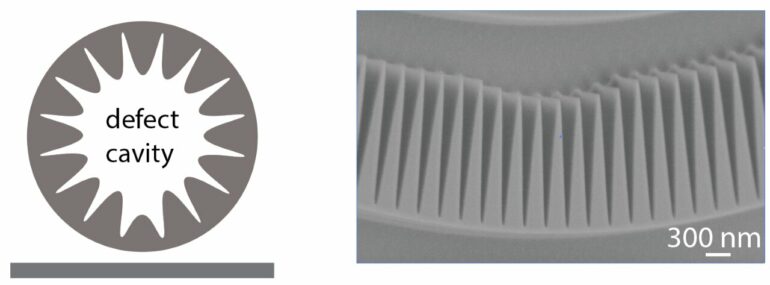Researchers including a postdoc at the University of Massachusetts Amherst have created a gear-shaped photonic crystal microring that increases the strength of light-matter interactions without sacrificing optical quality. The result is an on-chip microresonator with an optical quality factor 50 times better than the previous record in slow light devices that could improve microresonators used in a range of photonics applications, including sensing and metrology, nonlinear optics and cavity quantum electrodynamics.
Optical microresonators are structures that enhance light-matter interactions through a combination of long temporal confinement (i.e., high quality factor) and strong spatial confinement of an electromagnetic wave. The device the authors have developed in many ways integrates the best attributes of two types of optical microresonators—a photonic crystal and a whispering gallery mode resonator—in one device. While combining the two has been attempted in the past, previous microring devices that have succeeded in slowing light to increase interactions (a consequence of the photonic crystal) have had to sacrifice quality factor. In this new “microgear” photonic crystal ring, researchers observed modes with group velocity slowed down by 10 times relative to conventional microring modes without any degradation in quality factor.
The study, led by first author Xiyuan Lu and principal investigator Kartik Srinivasan, both from the National Institute of Standards and Technology (NIST) and the University of Maryland, appears in the January 2022 issue of Nature Photonics. UMass Amherst’s Andrew McClung, a postdoc in the photonics lab of Amir Arbabi and a former NIST colleague of Lu, provided modeling and computer simulations for the work.
“We show that the optical modes in these structures can show a much lower group velocity than the modes in standard integrated photonic waveguides (‘slow-light’) while maintaining low loss (high quality factor), and that we can further localize these modes spatially by introducing a ‘defect’ region within the resonator,” Srinivasan says. “Due to its unique combination of features, the overall system is appealing for many applications of microresonators, which in general are used to enhance light-matter interactions in a wide range of contexts, from single-photon sources to single-photon gates to nonlinear optics.”

Electromagnetic field simulation looking down at the top of the microring shows how the defect is localized to a region smaller than the entirety of the ring. © NIST/Lu
What differentiates this work, McClung says, is the geometry of their microring.
“In the past, people have put holes in the center of these rings to introduce the photonic crystal,” he says. “Instead of punching a hole, we created little bumps along the inside of the ring. This introduces the modulation you need and it perturbs the mode less aggressively.”
In the defect version of the device, instead of the bumps being perfectly periodic along the circumference of the ring, some number of bumps have a slightly different amplitude, forming a way to localize light within just a small fraction of the ring.
“Devices like ours can be used to enhance light-matter interaction, and we are currently working on using our microgear photonic crystal ring to increase the strength of interaction between light and a vapor of rubidium atoms for applications in quantum networking,” added Lu.
More information:
Xiyuan Lu et al, High-Q slow light and its localization in a photonic crystal microring, Nature Photonics (2021). DOI: 10.1038/s41566-021-00912-w
Provided by
University of Massachusetts Amherst
Citation:
Getting in gear: Researchers create a slow light device with high optical quality (2022, January 26)
